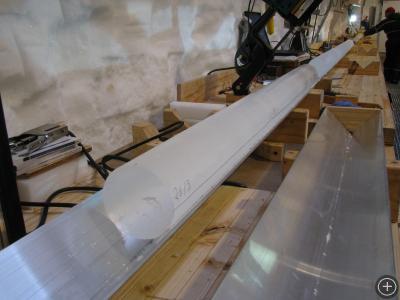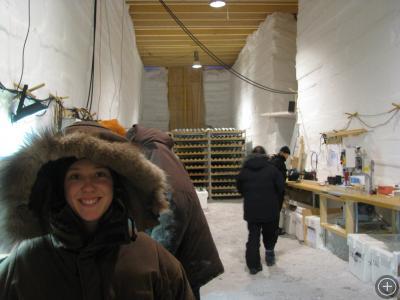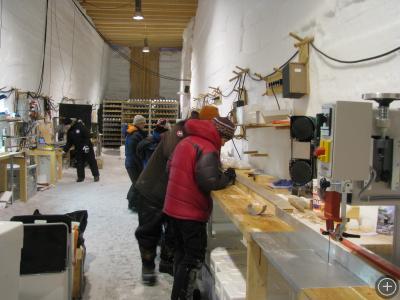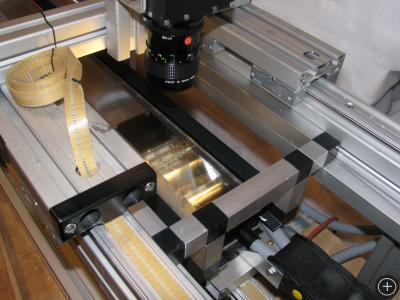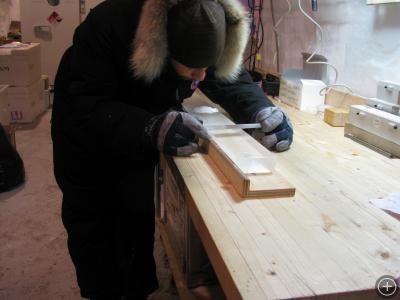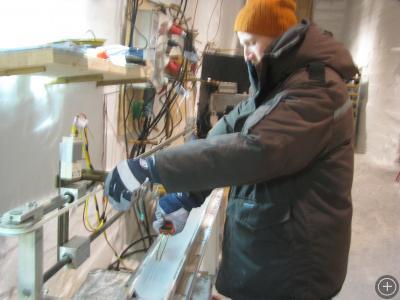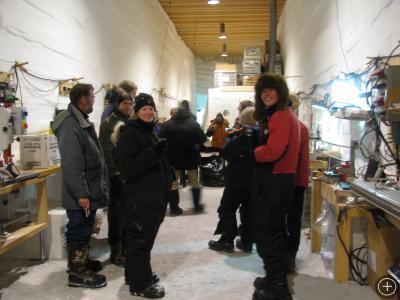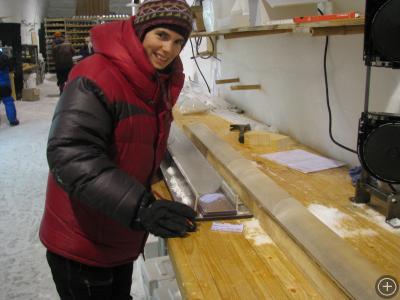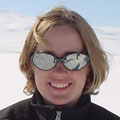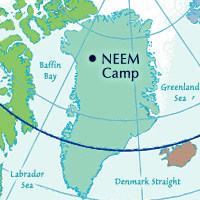In the Trenches
NEEM CAMP, GREENLAND– Over at the deep drilling site, work continues day and night. There are two shifts of drillers and core handlers who work around the clock (day shift and night shift) to ensure that as much core can be drilled in a single season as possible. Right now, the NEEM drillers are on pace to break the record for the most core drilled in a single season!
All of this work is completed in an 8 m (26 ft) deep trench that was painstakingly dug out last year (but with snow blowers…at least not with shovels!). This trench has been covered with a wooden roof (complete with sky lights), and makes for a fairly comfortable, albeit cold for the sake of the ice cores, working environment.
Descending the steep stairway from the surface into the system of trenches (one trench is for the drilling operation and one is for the science operation) is otherworldly. It really looks like a civilization of trolls has dug themselves a snow palace. Think Lord of the Rings meets North Pole. Connecting the drill trench and the science trench is a wide passageway through the snow, on the other end of which is a marvel of a laboratory. Several stations are set up where different measurements are being made—each station is manned by some of the best and the brightest graduate students around. Unlike most US drilling programs, for this program, a lot of the ice core measurements are being done on site. This eliminates the risk of something happening to the precious cores before the measurements can be made and helps reduce contamination from handling the core. Basically this hole in the snow in the middle of nowhere has been turned into one of the most advanced ice core laboratories in the world.
The trenches are cold, yes, but the group working keeps up morale by listening to music (lots of Bob Marley and Jack Johnson…fairly tropical selections) and taking frequent, mandatory tea and coffee breaks. There are too many nationalities (German, French, Japanese, Greek, Danish, Australian, American) in the trench to keep track of, and everyone pitches in to help everyone out, so that no one falls behind and the work continues seamlessly.
The Stations
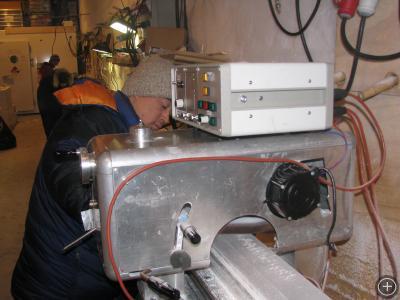
Atsushi works the Swiss Saw, which cuts the top of the core off to leave a flat surface for measurements.
The Swiss Saw is run by Atsushi from the Low Temperature Institute in Hokkaido, Japan, who happens to be a whiz at the thing, very fast and precise. He is hard to keep up with. The Swiss saw cuts the top of the ice core off, as it is lying down horizontally. This allows for several of the next measurements to be made, as it leaves a nice flat surface to work on.
The line scan is run by Vasileios from Denmark. The line scanner is a video camera set on a track that records an image of the cores after Vas, and his helper Kaitlin (Kaitlin agreed to help out for a bit in the science trench after we had most of our work done), have carefully shaved the top of the ice core so that it becomes perfectly clear. The line scan records the visual stratigraphy, or layering, in the ice core. The ice core is photographed against a dark background using indirect light, which allows for clear and cloudy bands in the ice to be imaged. The cloudy bands contain more impurities, especially dust, than the clear bands of ice, and show up white while the clear bands show up as black against the background. The bands are indications of seasonal cycles, with dustier ice with higher impurities originating in summer months.
The DEP (Dielectric Profile) is run by Lars from the Alfred Wegener Institute in Bremerhaven, Germany. The DEP is essentially two curved electrodes that are scraped down the top of the ice core (the cut that Atusushi made!) and record the conductivity and the permittivity of the ice which are sensitive to the acidity and the amount of sea salt in the ice. These, in turn, vary with the seasons, and so the DEP can be used to date the ice on a very fine scale.
The ECM (Electrical Conductivity Measurements) is run by Aslak, also from Denmark. The ECM consists of two electrodes, much like the DEP, which are drug down the ice core and record the electrical conductivity of the ice core. The electrical conductivity is sensitive, among other things, to peaks in acidity in the ice core due to volcanic eruptions. Where the electrodes record a peak in conductance is a layer where volcanic material has been deposited. Knowing when the volcano erupted helps then with dating the ice core. Together using the line scan, the DEP and the ECM together is a really powerful way of ensuring that the dating is done in the most accurate way possible…basically there are three independent measures of the annual and sub-annual layers in the ice.
The CFA (Continuous Flow Analysis) is run by 6 researchers in two shifts, and is really an amazing set up. The CFA essentially melts one section of the core (a “stick” or a rectangular section that has been cut out of the middle of the core by yet another army of science trenchers who man the saws), sucks the flow from the center of the melting ice, discards the waste water from the edges, and feeds the center flow to a series of analyzers which measure the melted ice core water for different chemicals. The concentration of people, instruments, and computers in the DFA lab is enough to produce a lot of heat, so the CFA has been housed in it’s own little insulated space to keep the rest of the science trench cold. The CFA lab reaches temperature of 30 deg C (around 85 deg F)! It’s a funny scene in there, with the 3 researchers in t-shirts while everyone else is bundled up in the science trench.
Physical Properties. Back in her own little room off of the science trench, Daphne of the LGGE in Grenoble, France, measures the size and the orientation of the crystals in the ice.
In addition to the different science stations, a bevy of other researchers works to cut and package the cores. When everyone is down there working together, it resembles an ice core ballet (just well-insulated and heavily clothed)! It really is amazing to watch.

 No comments
No comments 